- You are here:
- Home »
- Jones-Keen
Tag Archives for " Jones-Keen "
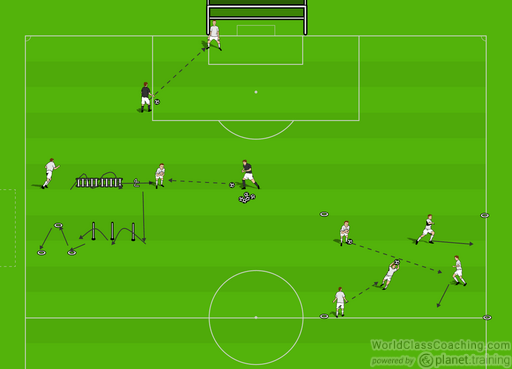
Tournament Goal Keeping
This is one of the articles and training sessions on goalkeeping and other topics that will be published this month in the Training Center. Click Here to learn how you can receive access to all of them.
By Josh Jones-Keen –
With summer here small sided tournaments are also here and with them they bring their own challenge for outfield players but also for those in goal.
The smaller and sometimes wider goals mean Keepers have to adjust their positioning more than if they were in a full size goal as shots are often hit at tight angles or cut back for a striker whose facing goal. Often the area is much smaller and Keepers might not be able to leave it, which brings its own problems! Distribution is also another challenge. Here is some prep that coaches and Keepers can work on for small tournaments.
Firstly read the rules! I was at a tournament the other day and there were a number of penalties for encroachment from a defender or for the Keeper leaving the box!
Shot Stopping
Most tournament goals are short and wide (not as wide as a full size but in comparison to the height they’re wide this means shots should be low and hard. Any shots higher should be a comfortable save for the Keeper getting across their goal with good footwork, quick short sidesteps. For diving saves:
Coaching Points
- Again good footwork is needed to get in to position
- Dive forwards to the ball, diving square or backwards could allow the ball to go for a corner or worse a goal if a mistake happens
- Body shape through the air and when landed should look like it would if catching a ball in to the chest area when standing
As well as dealing with shots a good way to practice footwork is with cone and ladder work. Once footwork is good you can add the shot stopping element to it.
Positioning
Like a regular game the Keeper should get down the line of the ball when the striker is preparing to shoot. The difficulty comes when with knowing how far to come off their line. This now depends on the size of the area.
Distribution
It’s important that the outfield work for the Keeper here. It’s tough if you’re looking at a field with no space and no movement. As a rule at least one defender should be free. Often there is a no kicking rule and sometimes a no over head throwing rule so we will look at rolling first.
Coaching Points
- Hold ball between palm and forearm with bent wrist
- Step forwards with the opposite foot, get low and bowl the ball along the floor
- Finger tips brush against the floor to ensure the ball doesn’t bobble/bounce
This can be practised one on one or if you have a group of Keepers I like to use it as a warm up in a 20 x 20 square. Coach shouts a type of distribution and the players perform the technique and move around the box. It’s also a great place to practice footwork.

By Josh Jones-Keen – Josh has been coaching Goalkeepers for over a decade & has both Outfield and Goalkeeper coaching awards from England and Scotland. He’s coached at a number of levels from grassroots to semipro and currently coaches non league Women’s team as well as a local academy.
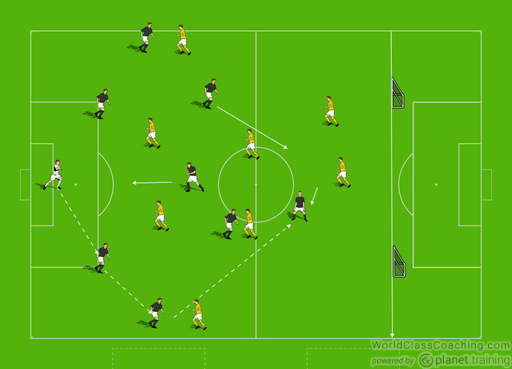
Playing Out of the Back
By Josh Jones-Keen –
Once a Keeper has the fundamentals of distribution it’s time to move on to how you would like them to play as part of the team’s tactics. This phase of play session looks at the Keeper starting play from the back.

Deciding how to play has a lot to do with the starting positions of the outfield players. If the players are not playing how the Keeper needs they must tell them. If starting position is as above the movement needs to be good, the defensive midfielder can drop but not too quickly. One centre midfielder can push to support the attackers.
[wpsharely id=”821″][/wpsharely]Coaching Points
- The Keeper must decide to either play to feet or in space
- Does the player have enough space around them to play in to space
- If so is the ball in front of them to run on to & can they control on their back foot?
- Ability to find players with the correct technique
- Rolling, clean along the ground
- Over arm, bouncing in the right place and height
- Picking the right person depending on the shape, is the defensive midfielder a good place to pass to if there is limited or no support?
Progression
Numbers can be added to fill the space more; this will work on the Keepers accuracy and decision making.
This then will progress in to a full size pitch. In an ideal world the team you are trying to coach will have 1 more player then the defending team. This allows for higher success. On the full pitch set up as near to an 11 vs 11 tactics as possible. The aim is for the team to replicate the movement and build up as they did on the smaller pitch.
By Josh Jones-Keen – Josh has been coaching Goalkeepers for over a decade & has both Outfield and Goalkeeper coaching awards from England and Scotland. He’s coached at a number of levels from grassroots to semipro and currently coaches non league Women’s team as well as a local academy.
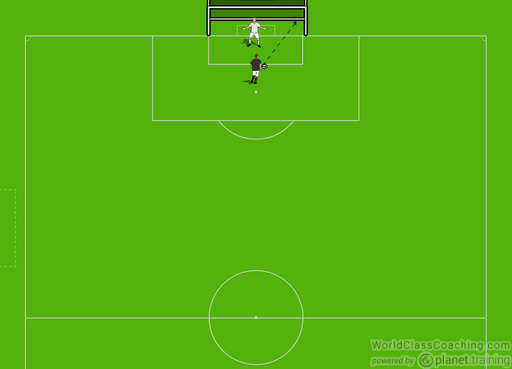
The Art of Saving a Penalty
By Josh Jones-Keen –
Often teams practice penalties but the focus is always on trying to score them. Outfield players can practice penalties to the hilt but nothing can replicate the pressure of doing it in a real game.

As for the Keeper there is no pressure. Not in training and not in a game. If you’ve got to penalties your Keeper has already done their job of not conceding in actual time. Now is the time to do the right thing and hope you get some luck on the way. This is the mentality that must be coached for majority of Keepers. Keep the pressure off so they don’t freeze.
The first drill works on the Keepers saving technique. The coach starts by pointing to a corner and then tossing the ball to that corner. This can progress to the coach drop volleying to add more power and precision to the ball. To then progress the coach could point to one corner and play the ball in the other corner. Can the Keeper keep calm and remember it’s going the other way, and then the Coach should play the ball either side without pointing. Can the Keeper now judge the body shape of striker and work out the right way?
Distance is the key here; I often start 8/10 yards away and make it harder and faster the closer to the goal, to within 5 yards. Then start working back out to I’m striking them on the drop volley around the penalty spot.
[wpsharely id=”821″][/wpsharely]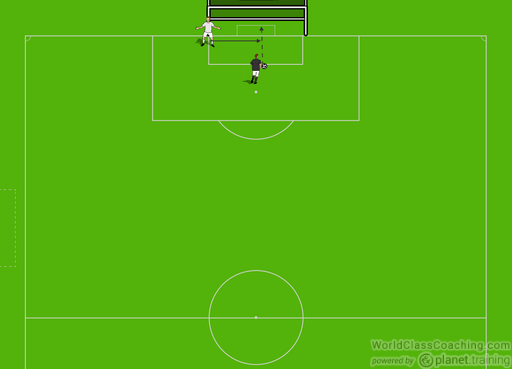
Here the Keeper starts on the other side of the Goal and the Coach strikes the ball in to the centre of the goal. The Keeper must dive across the goal to make the save. The main key point here is the dive.
To get the perfect takeoff the Keeper must propel them with the correct leg. With the Keeper facing the striker their inside leg facing towards goal must be used to push off. If the outside leg is used this is what creates Keepers rotating. In a game this is bad news as it means they cannot react to the next shot but in this case it could cost precious fractions of seconds which could be the difference to winning and losing.
Coaching Points
- Watch and judge the run up, you can tell a lot about where the ball is going based on the strikers run
- Make your decision as late as possible. React quickly.
- Dive well; know how quick you can cover ground. Push off with the inside leg
- Go two handed, move them quickly if needed
- Use the momentum of your arms pushing through to push the ball wide
By Josh Jones-Keen – Josh has been coaching Goalkeepers for over a decade & has both Outfield and Goalkeeper coaching awards from England and Scotland. He’s coached at a number of levels from grassroots to semipro and currently coaches non league Women’s team as well as a local academy.
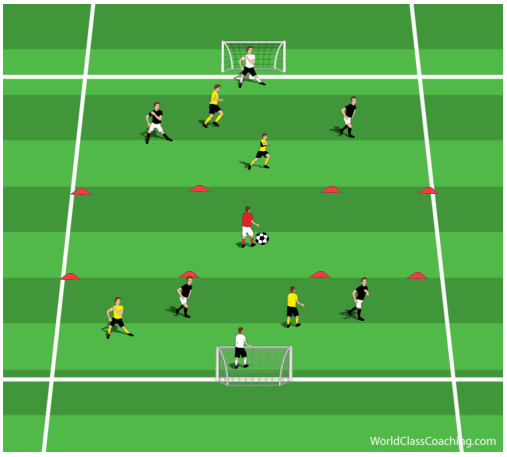
Why is David De Gea so Good?
By Josh Jones-Keen –
David De Gea has just won Man United’s player of the year for the 3rd time in a row. This is a great achievement and one that might not be beaten for some time. Some will say this is indicative of how poor Man Utd are currently however let’s put this in perspective, whilst far from their recent best they are still chasing a champions league spot and have the chance to win the FA Cup for the first time in over 10 years. A lot of what has been good about Man Utd this season has come from the back so let’s look at what makes De Gea so good and how can try to emulate him.
Communication
When De Gea first started playing for United he looked a bit lost and out of sorts as did his back line even though it was one made up of great experience. Now whilst the defenders are not anywhere nearly as good as previous incumbents De Gea has got them listening to him and they are ready to be commanded. This drill will help start to get the Keeper talking. Effective communicating can add so much to a team.
Make sure when communicating orders are brief and to the point, direct and have clear ownership. For example how many times do you hear players ‘Back if you need/want’, I tell me Keepers to be positive and if they want the ball to demand it not suggest.
These instructions cover every drill a Keeper does including playing time come match day. Here are some to use and some to avoid:
- Keeper – When call this the Keeper is staking a claim to come and get that ball. Defenders know to get out the way and attackers know what’s coming. A keeper should be saying this when comfortable to let a shot come through to them and especially when claiming a cross.
- Mark (Avoid) also ‘Mark Up’, get your Keeper in to the habit of telling defenders who to mark ‘Jill number 10’
- 18yrds – Use this instead of the traditional ‘Step Up’ or ‘Get Out’ here players know exactly where to go
- Away – Tells players to just clear the ball. It’s not the best but equivalent of ‘if in doubt clear out’
Dealing with Crosses
Again when first coming to England De Gea had looked like he almost had never caught a crossed ball in his life, now he plucks them out of the air with ease.
Coaching Points
- Receiving high balls in the W formation
- Positioning, are they in a good place to get under the ball
- Footwork, are they moving around defenders to claim the ball
- Communication, ‘Away’ or ‘Keepers’
- Body Shape, is it correct when receiving the ball and is it ready to start a counter attack
Set Up
- 50Yrds by 35yrds
- 6 on 6 but 2v2 in each sq, to start with each player is restricted to their squares
- Attackers must get the ball wide to score from a cross
- Goal Keepers try to intercept and start counter attack

Shot Stopping
Shot stopping is what really brings De Gea the plaudits. Time and time again he will pull off a save that adds to United’s points total. They would be a lot worse off without him. If saves were celebrated like goals DDG would be an even more busy man.
Set Up
The field is 50 yards long, split in to 3 zones. One end zone is 18 yards deep while the other end zone is 25 yards deep. The different size end zone will encourage different types of shots.
Coaching Points
- On top of saving the ball in the correct way Keepers should look for
- Good positioning – before and after the shot
- Good body shape – before and after the shot
By Josh Jones-Keen – Josh has been coaching Goalkeepers for over a decade & has both Outfield and Goalkeeper coaching awards from England and Scotland. He’s coached at a number of levels from grassroots to semipro and currently coaches non league Women’s team as well as a local academy.

Shot Stopping Game
By Josh Jones-Keen –
This is a fun but competitive drill recently seen performed by Burnley FC. The aim of this game is to keep the ball out of the net by any means possible. After all that’s what we’re paid to do.
This can be done 1 on 1 or with multiple Keepers by rotating more frequently. If 1 on 1 I would go best out of 10 (or whatever time permits). I would use this drill at the end of a tough session to add some light relief and not to take things too seriously as opposed to Small Sided games with the rest of the squad. These types of drills also help increase camaraderie between Keepers as a team.

[wpsharely id=”821″][/wpsharely]
Firstly the Keeper must jump over the hurdle and the striker will shout which cone (number them 1-4) the Keeper must touch the cone and reset back to the middle before the striker 1) Drop Volley, 2) Roll on the ground and strike 3) Dead Ball Strike all from the edge of the area.
As mentioned before the Keeper needs to keep the ball out of the net but praise good technique.
Progression
The Keeper starts the same and the striker still calls the cone however this time they are on the edge of the D, when the Keeper returns to the set position the Striker can roll the ball and must strike it before the 18 yard box.
By Josh Jones-Keen – Josh has been coaching Goalkeepers for over a decade & has both Outfield and Goalkeeper coaching awards from England and Scotland. He’s coached at a number of levels from grassroots to semipro and currently coaches non league Women’s team as well as a local academy.
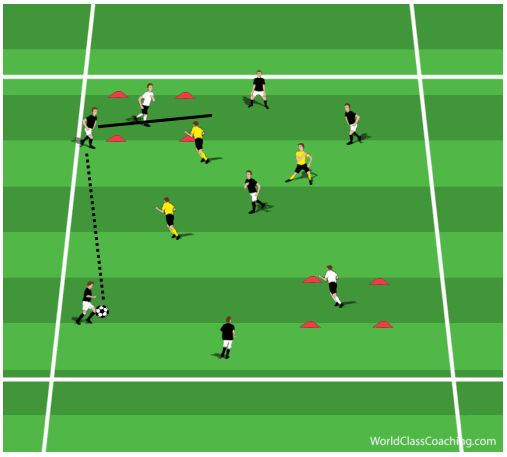
Dealing with 1 v 1’s
By Josh Jones-Keen –
This is another topic and drill that was discussed at the recent FA Keepers Conference. As players get faster and the game changes dealing with 1:1’s is becoming more & more important.
40×40 yard box with two small boxes in side for the Keepers.
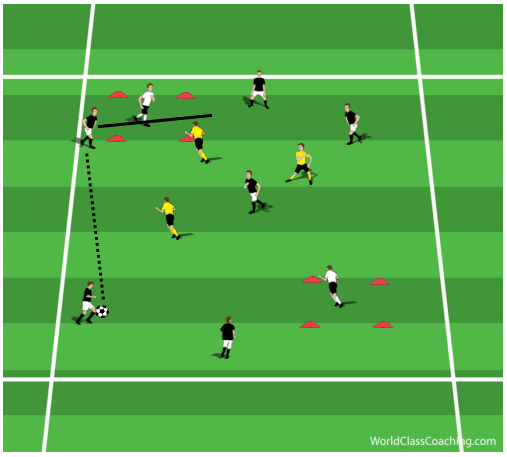
6v 3 with a Keeper in each box, overloaded intentionally to create chance for the Keeper to practice 1 on 1’s, swap the 3’s around. Outfield players score by running the ball through the box Keepers score a point by forcing the player out of the box or by making a save.
Progression
Keepers can now score 3 goals if they leave the box and intercept a pass or steal the ball from a player’s foot with their hands.
Progression 2
To add more realism, if the Keeper leaves the box they can now only regain the ball with their feet
If the defending team win the ball they can now try and keep the ball using the Keepers. 5 passes equals a goal.
Coaching Points
- Positioning, down the line of the ball
- Good footwork, follow the ball across as it’s played
- Body shape, showing the attacker out of the box
- Decision making, when to pounce when to delay or deny space
By Josh Jones-Keen – Josh has been coaching Goalkeepers for over a decade & has both Outfield and Goalkeeper coaching awards from England and Scotland. He’s coached at a number of levels from grassroots to semipro and currently coaches non league Women’s team as well as a local academy.
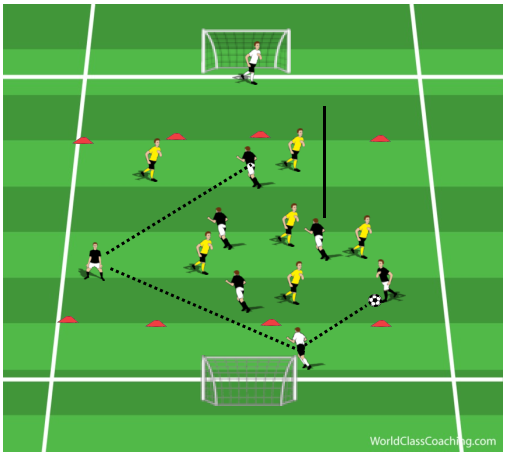
Keepers Receiving to Feet
By Josh Jones-Keen –
I have recently attended the FA’s Goal Keeper Conference at St George’s Park. Over the weekend many topics were discussed and session plans shared, this one caught my eye. I’ve been lucky enough to work with Keepers who love the ball at their feet but a lot of Keepers, at all ages, that haven’t been taught correctly often ‘Get Rid’ of the ball at any chance. This game invites them to be part of the attacking team and they can see how they can affect the game to create chances.
The objective is to use the Keeper to create chances, this might mean adding a rule in stating that to score a goal the team’s Keeper must have a touch first.

Attacking players cannot enter the end zone unless their team is in possession; this means no closing down the Keeper!
Progression
- Off sides no apply in the end zones
- Teams can score without going through the Keeper however if they do go through the Keeper and score it’s worth 3!
Progression 2
Out of possession teams can now send one player to close down the Keeper. The Keeper must decide when to play, when to dribble or when to be safe.
Coaching Points
- Good, clear communication
- Correct body shape
- Good positioning, wide of the post
- Correct passing technique
- Reading of the game, who is best to pass to and why
By Josh Jones-Keen – Josh has been coaching Goalkeepers for over a decade & has both Outfield and Goalkeeper coaching awards from England and Scotland. He’s coached at a number of levels from grassroots to semipro and currently coaches non league Women’s team as well as a local academy.
